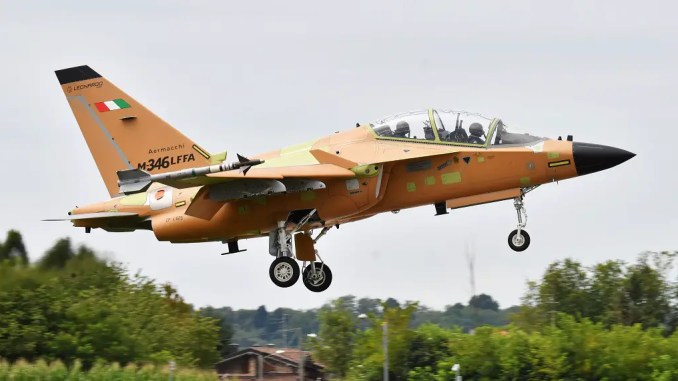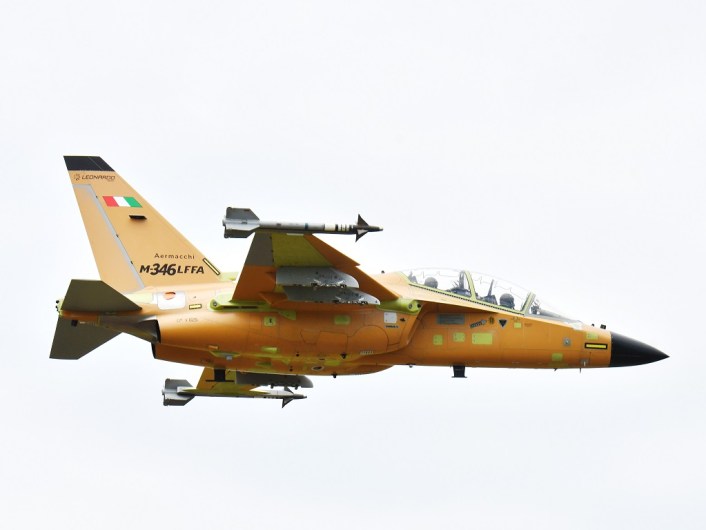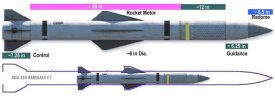You are using an out of date browser. It may not display this or other websites correctly.
You should upgrade or use an alternative browser.
You should upgrade or use an alternative browser.
Active & Future Fighter Aircrafts - Around the World
- Thread starter Scorpio
- Start date
You must realize something, There is a limit to something totally of the books, due to limitations in tech there will be overlaps in designs.They took fuselage from F35, engine nozzles from F22 and wings from B21 and Wala it's Tempest.
space cadet
SENIOR MEMBER
I saw that one in the movie Fire Fox, staring Clint Eastwood, them Russians are getting creative
M-346 Light Fighter Family of Aircraft (LFFA) Performs First Flight in Complete Configuration
 The prototype of the M-346 LFFA landing after the first flight at Venegono airport
The prototype of the M-346 LFFA landing after the first flight at Venegono airport
The aircraft retains all its training features while being able to perform also a wide range of operational air-to-air and air-to-ground missions.
The new prototype of the Leonardo M-346 Light Fighter Family of Aircraft (LFFA) performed its first flight on July 13, 2020, from Venegono airport, where the company’s final assembly lines are based. The aircraft, formerly known as M-346 Fighter Attack (FA), is the first prototype in complete configuration, featuring all the equipment that differentiates it from the standard M-346 Advanced Jet Trainer (AJT).
The prototype, with serial CPX625, was captured by photographer Oscar Bernardi, who sent us the photos you can see here. The most visible differences from the standard AJT configuration are the two wingtip missile rails, that bring the total hardpoints to seven (two on the wingtips, four under the wings and one under the fuselage), a couple on new antennas on the nose (in front of the cockpit) and under the fuselage (under the both engines), and the Defensive Aid Sub System (DASS).
The DASS features a Radar Warning Receiver (RWR), probably the new SEER digital RWR developed by Leonardo with sensors in the tail and near the wing root’s leading edge (beside the air intakes), a Missile Warning System (MWS), with two sensors along the RWR ones beside the air intakes and two near the wing root’s trailing edge, together with chaff/flare dispensers.
The M-346 LFFA variant is designed to retain the full dual role capability of the AJT version, already in service with the Italian, Israeli, Polish and Singapore Air Forces, while incorporating also some new features like a tactical data link, Grifo-346 mechanical scan, multi-mode radar, new secure radios and IFF system (Identification Friend or Foe), and a stronger airframe.
 The M-346 LFFA prototype performing a fly-by at Venegono airport.
The M-346 LFFA prototype performing a fly-by at Venegono airport.

 theaviationist.com
theaviationist.com

The aircraft retains all its training features while being able to perform also a wide range of operational air-to-air and air-to-ground missions.
The new prototype of the Leonardo M-346 Light Fighter Family of Aircraft (LFFA) performed its first flight on July 13, 2020, from Venegono airport, where the company’s final assembly lines are based. The aircraft, formerly known as M-346 Fighter Attack (FA), is the first prototype in complete configuration, featuring all the equipment that differentiates it from the standard M-346 Advanced Jet Trainer (AJT).
The prototype, with serial CPX625, was captured by photographer Oscar Bernardi, who sent us the photos you can see here. The most visible differences from the standard AJT configuration are the two wingtip missile rails, that bring the total hardpoints to seven (two on the wingtips, four under the wings and one under the fuselage), a couple on new antennas on the nose (in front of the cockpit) and under the fuselage (under the both engines), and the Defensive Aid Sub System (DASS).
The DASS features a Radar Warning Receiver (RWR), probably the new SEER digital RWR developed by Leonardo with sensors in the tail and near the wing root’s leading edge (beside the air intakes), a Missile Warning System (MWS), with two sensors along the RWR ones beside the air intakes and two near the wing root’s trailing edge, together with chaff/flare dispensers.
The M-346 LFFA variant is designed to retain the full dual role capability of the AJT version, already in service with the Italian, Israeli, Polish and Singapore Air Forces, while incorporating also some new features like a tactical data link, Grifo-346 mechanical scan, multi-mode radar, new secure radios and IFF system (Identification Friend or Foe), and a stronger airframe.
 The M-346 LFFA prototype performing a fly-by at Venegono airport.
The M-346 LFFA prototype performing a fly-by at Venegono airport. 
M-346 Light Fighter Family of Aircraft (LFFA) Performs First Flight in Complete Configuration
The aircraft retains all its training features while being able to perform also a wide range of operational air-to-air and air-to-ground missions. The new
Mitchell Gant...I saw that one in the movie Fire Fox, staring Clint Eastwood, them Russians are getting creative
View attachment 14975
Think in Russian.... You must think in russian

Russian Ministry of Defense Confirms Order for 76 Su-57 Fighter Jets - MilitaryLeak.COM
Russian President Vladimir Putin yesterday announced the purchase of 76 of the latest Su-57 fighters by the Ministry of Defense, which are to enter service with three aviation regiments by 2028.
 militaryleak.com
militaryleak.com
China has developed the first two seats stealth fighter aircraft based on the J-20, stealth, twin-engine, and fifth-generation fighter aircraft developed by China in Chengdu Aerospace Corporation. In January 2019, China has announced the development of the two-seat variant of the J-20.
The Chengdu J-20 also nicknamed as Mighty Dragon, NATO reporting name is Black Eagle is a single-seat, twinjet, all-weather, stealth, and fifth-generation fighter aircraft developed by China's Chengdu Aerospace Corporation for the People's Liberation Army Air Force (PLAAF).
The J-20 is designed as an air superiority fighter with precision strike capability; it descends from the J-XX program of the 1990s. It made its maiden flight on 11 January 2011 and was officially revealed at the 2016 China International Aviation & Aerospace Exhibition.
The J-20 was introduced into service with the Chinese Air Force in March 2017 and began its combat training phase in September 2017. The frst J-20 combat unit was formed in February 2018.
The J-20 stealth fighter aircraft has a maximum speed of 2100 km/h and the development for a super cruising without afterburners is still under development. It has a length of 20 m with a wingspan of 13 m and a height of 4.45 m. It has an empty weight of 19,391 kg and a loaded weight of 32,092 kg. The maximum takeoff weight is 36,288 kg. The aircraft is powered by two Shenyang WS-10G afterburning turbofan engines. It can produce 76.18 KN dry thrust and 122.3 or 179.9 KN with afterburner.
The main weapon bay is capable of housing both short and long-range air-to-air missiles (AAM; PL-9, PL-12C/D & PL-15 – PL-21) while the two smaller lateral weapon bays behind the air inlets are intended for short-range AAMs (PL-10). These side bays allow closure of the bay doors prior to firing the missile, thus allowing the missile to be fired in the shortest time possible as well as enhancing stealth. The J-20 is reported to lack an internal automatic cannon or rotary cannon, suggesting the aircraft is not intended to be used in short-range dogfight engagements with other aircraft but engage them with from long standoff ranges with missiles such as the PL-15 and PL-21.
While the fighter typically carries weapons internally, the wings include four hardpoints to extend the ferrying range by carrying auxiliary fuel tanks. However, much like the F-22, the J-20 is unlikely to carry fuel tanks on combat missions due to its vulnerability in such a configuration, thus this configuration remains valuable for peacetime operations, such as transiting between airbases.[53] The fighter is able to carry four medium/long-range AAMs in the main bay and short-range missile one in each lateral weapon bay of the aircraft. A staggered arrangement with six PL-15s is possible depending on the rail launcher for missile mounted in the future.
The Peregrine™ missile is a small, fast, lightweight air-to-air weapon for use against drones, manned aircraft and cruise missiles. Built with additive manufacturing and readily available materials, the missiles are low cost. They are also lighter, effectively doubling the number of missiles that current fighter jets can carry.
The Peregrine is being developed with Raytheon’s own funds, according to Mark Noyes, a senior business development official in the company’s air warfare systems sector. While Raytheon is not developing the missile to meet a specific Air Force or Navy requirement, the Peregrine is meant to meet the Pentagon’s need for large numbers of affordable weapons that still “overwhelm an enemy," Noyes said.
The weapon is expected to measure just under 6 feet long and 150 pounds, less than half the weight and length of Raytheon’s AIM-120 Advanced Medium-Range Air-to-Air Missile and AIM-9X Sidewinder that fly on fighters across the Defense Department.
“We’re able to take the best of both of those missiles and, based on what we see as the customer’s requirements and gaps, we are combining them into this new missile,” Noyes said.
Peregrine “combines the range and the autonomy of the AMRAAM with the maneuverability characteristics of the AIM-9X” with extreme maneuverability as it approaches its target. The weapon will cost “significantly less" to buy and maintain than the AIM-120 or AIM-9X, and is faster to develop, thanks to ready-made components and additive manufacturing.
The Peregrine will have a multi-mode, autonomous seeker that includes infrared imaging. It uses a “new, high-performance propulsion system" to boost speed, Noyes said. He would only characterize the missile’s range as “from visual range to within medium range” but said Peregrine is a supersonic munition.
The all-weather, day or night weapon has a blast fragmentation warhead and a “new lightweight airframe and high-performance modular control system” that allows for highly accurate targeting, Noyes said.
He added that the Peregrine will fit into the current air-to-air weapon stations on all fourth- and fifth-generation aircraft pylons, and can sit in the weapons bay of the F-35. Noyes declined to comment on whether it will fit in the F-22’s weapon bays.
Peregrine is meant to complement, not replace, the AMRAAM and Sidewinder. The AIM-9X will still be the world’s best close-in dogfighting missile, Noyes said. It remains to be seen if the Peregrine will match the Sidewinder in close-range maneuverability.
Raytheon declined to say when the Peregrine could be ready for production or which components of the previous missiles would be reused.
However, the company wants to collaborate with the military services before committing to a final configuration to “make sure they resonate with the process and the direction we’re going in on the design of this missile,” Noyes said.
Lockheed Martin in recent years has been developing a similar concept, called the “Cuda,” which would offer comparable size and weight. In June, the Air Force announced that Lockheed is also developing an AMRAAM replacement called the AIM-260. The latter missile would be the same overall size as AMRAAM, but with much greater range, maneuverability, and less vulnerability to jamming.
Attachments
>> This missile is called the "pilot killer", a very vicious weapon. Adopting a unique pointing warhead, the "pre-burst point" laser proximity fuze can control the burst point more accurately and is difficult to interfere.
The missile warhead explodes near the cockpit of the enemy aircraft and forms directional blasting energy fragments. Able to hit as many fragments as possible on the target fighter. Achieve the killing effect of killing enemy pilots with one blow. Compared with shooting down an enemy aircraft, it is clear that the combat effectiveness of killing an enemy pilot is more ideal. The variant of this missile is China's Pl-5EII missile.


The missile warhead explodes near the cockpit of the enemy aircraft and forms directional blasting energy fragments. Able to hit as many fragments as possible on the target fighter. Achieve the killing effect of killing enemy pilots with one blow. Compared with shooting down an enemy aircraft, it is clear that the combat effectiveness of killing an enemy pilot is more ideal. The variant of this missile is China's Pl-5EII missile.
most of the cases it's total individual fantasy or an attempt to mislead.You must realize something, There is a limit to something totally of the books, due to limitations in tech there will be overlaps in designs.
otherwise, which serious org. in it's true sense would like to leak a design of futuristic weapons /flaying objects!
People who are acquainted with basics of technology and aerodynamics, can easily differentiate a logical design from a BS model.

